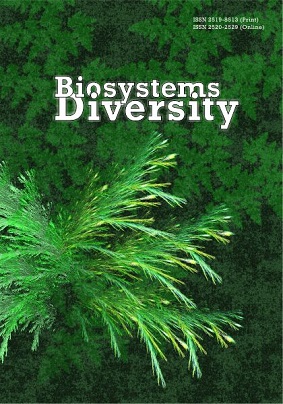Temperature effect on the temporal dynamic of terrestrial invertebrates in technosols formed after reclamation at a post-mining site in Ukrainian steppe drylands
Temperature effect on the temporal dynamic of terrestrial invertebrates in technosols formed after reclamation at a post-mining site in Ukrainian steppe drylands
Author(s): O. Y. Pakhomov, O. M. Kunakh, A.V. Babchenko, M.P. Fedushko, N. I. Demchuk, L.S. Bezuhla, O. S. TkachenkoSubject(s): Agriculture, Energy and Environmental Studies, Human Ecology, Environmental interactions, Present Times (2010 - today)
Published by: Дніпропетровський національний університет імені Олеся Гончара
Keywords: species response; temperature; niche; tolerance; reclamation; gradient; temporal dynamic;
Summary/Abstract: The research was carried out at the Research Centre of the Dnipro State Agrarian and Economic University in Pokrov city. Sampling was carried out in 2013–2015 on a variant of artificial soil (technosols) formed on loess-like loam, red-brown clay, green-grey clay, technological mixture of rocks, and also formed on loess-like loam with a humus-rich 70 cm top soil layer. To investigate the spatiotemporal variation in the abundance, species richness and species composition of invertebrate assemblages within the experimental polygon, the animals were sampled using pitfall traps. In total, 60 pitfall traps were operated simultaneously during each sampling period. Each year the pitfalls were emptied 26 times every 7–9 days. Invertebrates (Arthropoda and Mollusca) of 6 classes, 13 orders, 50 families and 202 species or parataxonomic units were recorded. Diplopoda was most abundant taxonomic group, though it was represented by only one species Rossiulus kessleri (Lohmander, 1927). Coleoptera and Araneae were the most numerous taxonomic groups. Readily available water for plants, precipitation, wind speed, atmospheric temperature (daily minimum, daily maximum, daily mean), atmospheric humidity and atmospheric pressure were used as environmental predictors. Two dimension geographic coordinates of the sampling locations were used to generate a set of orthogonal eigenvector-based spatial variables. Time series of sampling dates were used to generate a set of orthogonal eigenvector-based temporal variables. The moisture content in the technosols was revealed to be the most important factor determining the temporal dynamics of the terrestrial invertebrate community in conditions of semi-arid climate and the ecosystem which formed as a result of the reclamation process. Following soil moisture, the factor most strongly affecting invertebrates in the technosols was temperature. From the total set of the invertebrates, two relatively homogeneous species groups in terms of thermal preferences were extracted: the microtemperature and mesotemperature groups. The microtemperature species are more tolerant to the thermal factor, and the mesotemperature species are more sensitive. The Huisman-OlffFresco approach expanded by Jansen-Oksanen provides a wide set of ecologically relevant models which are able to explain species response. The species response to temperature is affected by a complex of other environmental, temporal and spatial factors. The effect of other factors on the species response must be previously extracted to find real estimations of the species temperature optima and tolerance. The approaches to solving this problem may be the object of future investigation.
Journal: Biosystems Diversity
- Issue Year: 27/2019
- Issue No: 4
- Page Range: 322-328
- Page Count: 7
- Language: English

